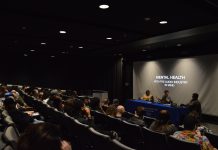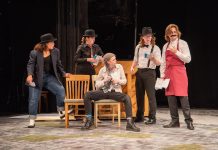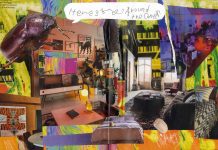On Aug. 31, Webster students gathered at the Garden Cafe to watch local musicians perform in BrewBops Music Fest. Consisting of over 8 bands, students came with one thing missing; ear protection.
The National Institute on Deafness and Other Communication Disorders stated on their website “only eight percent of people wear ear protection to concerts.”
According to audio professionals, like

Gleghorn at Sound Access STL, the risk of hearing loss increases because concerts are significantly louder than the recommended amount of exposure. This repetitive exposure to harmful environments can lead to long lasting hearing issues.
Professor Bill Elliot teaches Light, Sound, and Electricity in the biological science department at Webster. According to Elliot, the risk of hearing damage is high for the young adult age group. He explained that the cochlea in our ears are little hairs that bend back and forth when we hear loud noises. He described how they get damaged through an example using a credit card.
“Have you ever had a case where you had to replace your credit card?” Elliot said. “When you receive the new card you are instructed to destroy the old card. If you do what I sometimes do and fold the card in half. If you do that you also fold it towards the other side and when you fold it a number of times the center is weak enough. Think of this like the cochlea in your ear, so when you go to any setting this is how they are in motion. If you go back repeatedly, you keep bending that credit card.”
Other audio production majors are also conscious of the potential loss of hearing. Senior Drew Brodsky studies audio production at Webster.
The reasons why people do not wear ear protection varies from accessibility issues to social norms.
“I think some people don’t wear them as an aesthetic choice,” Brodsky said. “People also overlook their sense of hearing, whereas I need it for my lifestyle and my job.”
Long term hearing loss is far more damaging than perceived.
“Without hearing, it becomes a social issue where you can’t engage with media and people the way you normally would,” Brodsky said.
Filtered ear protection is what is recommended by Sound Access STL. Audio production majors like Brodsky also warn of the risks leading to potential loss of hearing. Brodsky said that the purpose of filtered protection is to attenuate frequencies.
The silver circle in the middle is a filter that is made to even out the volume. Human hearing is between 20 hertz and 20 kilohertz, so anything above that is harmful to the ear. Filtered ear protection brings the overall frequency down so one is still capable of enjoying the music just at a lower volume.
Drug stores and places like Guitar Center sell ear protection in order help with hearing in loud environments. Local venues often sell ear plugs for as cheap as fifty cents. Certain local bands and venues even give away earplugs for free at their concerts.
If hearing loss is prevalent, Sound Access STL offers hearing evaluations and filtered ear protection. Dr. Gleghorn of Sound Access STL makes personalized molded ear protection and in-ear monitors to help musicians and audio enthusiasts. Other audiologists can also help provide ways to care for and prevent hearing loss.
Repetitive exposure to loud environments and concerts can have a lasting effect on the way someone can hear. Ear protection is able to help prevent a significant portion of those issues.
Even if it is just one concert, as Dr. Gleghorn said “It only takes one exposure to damage your hearing.”



